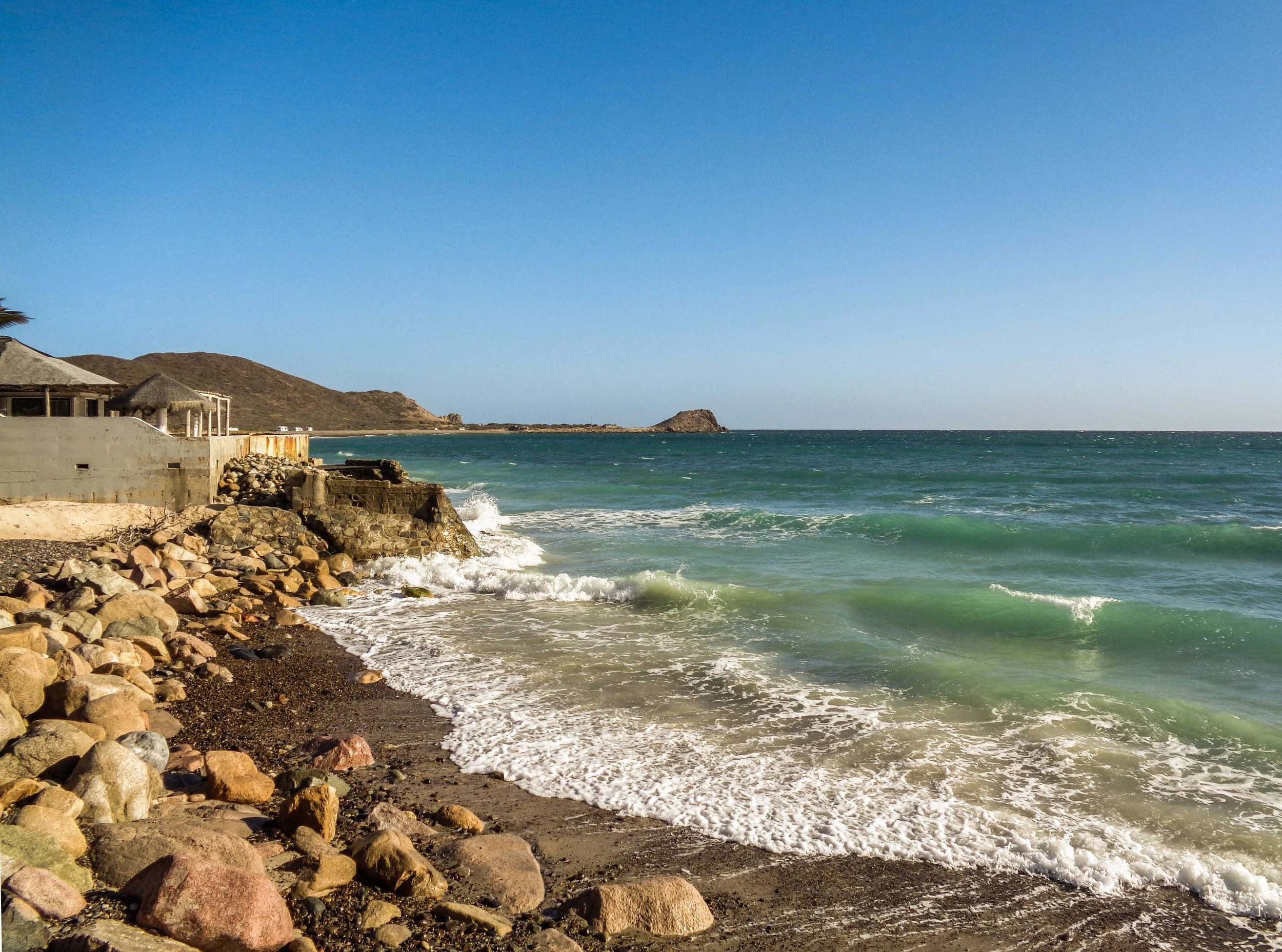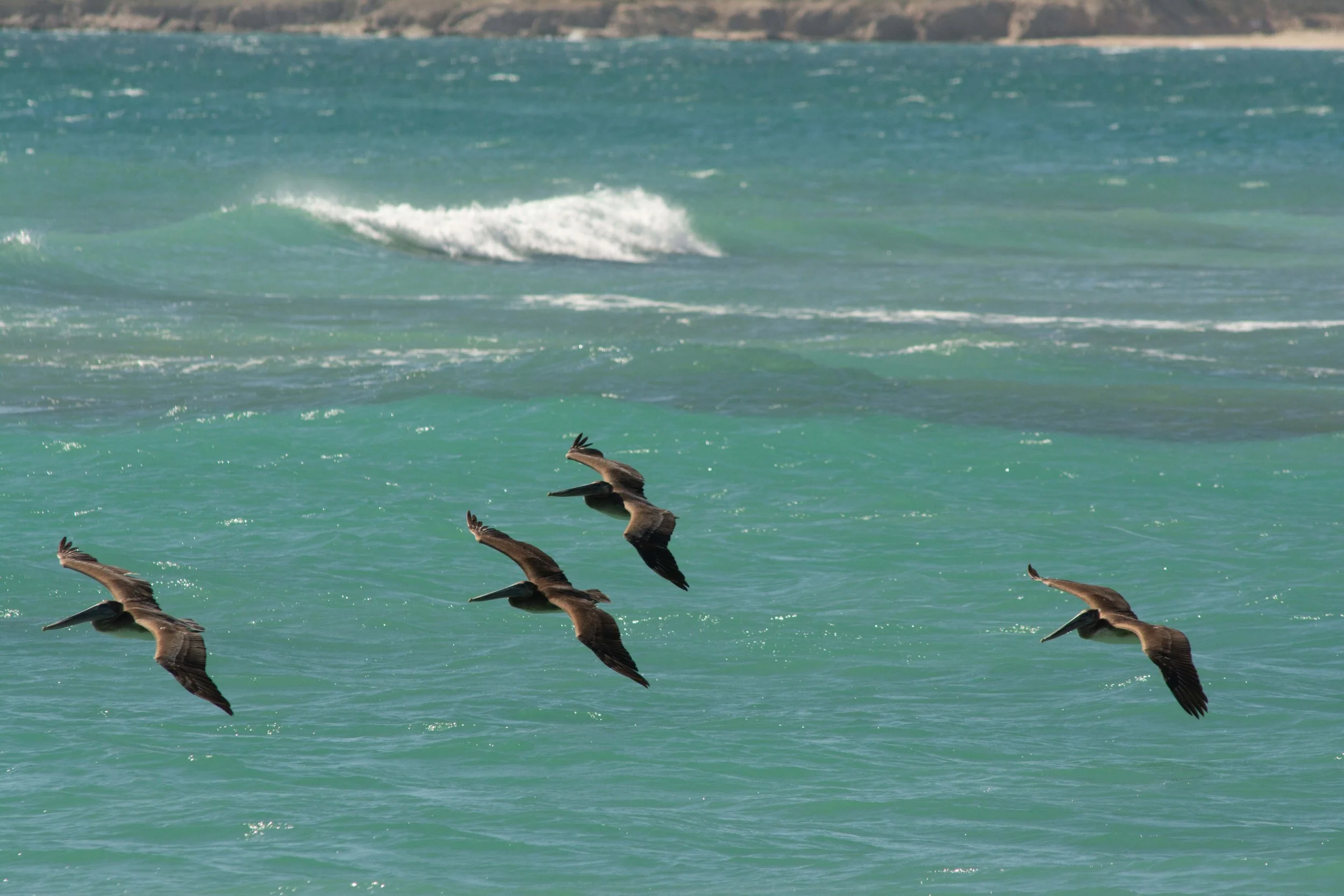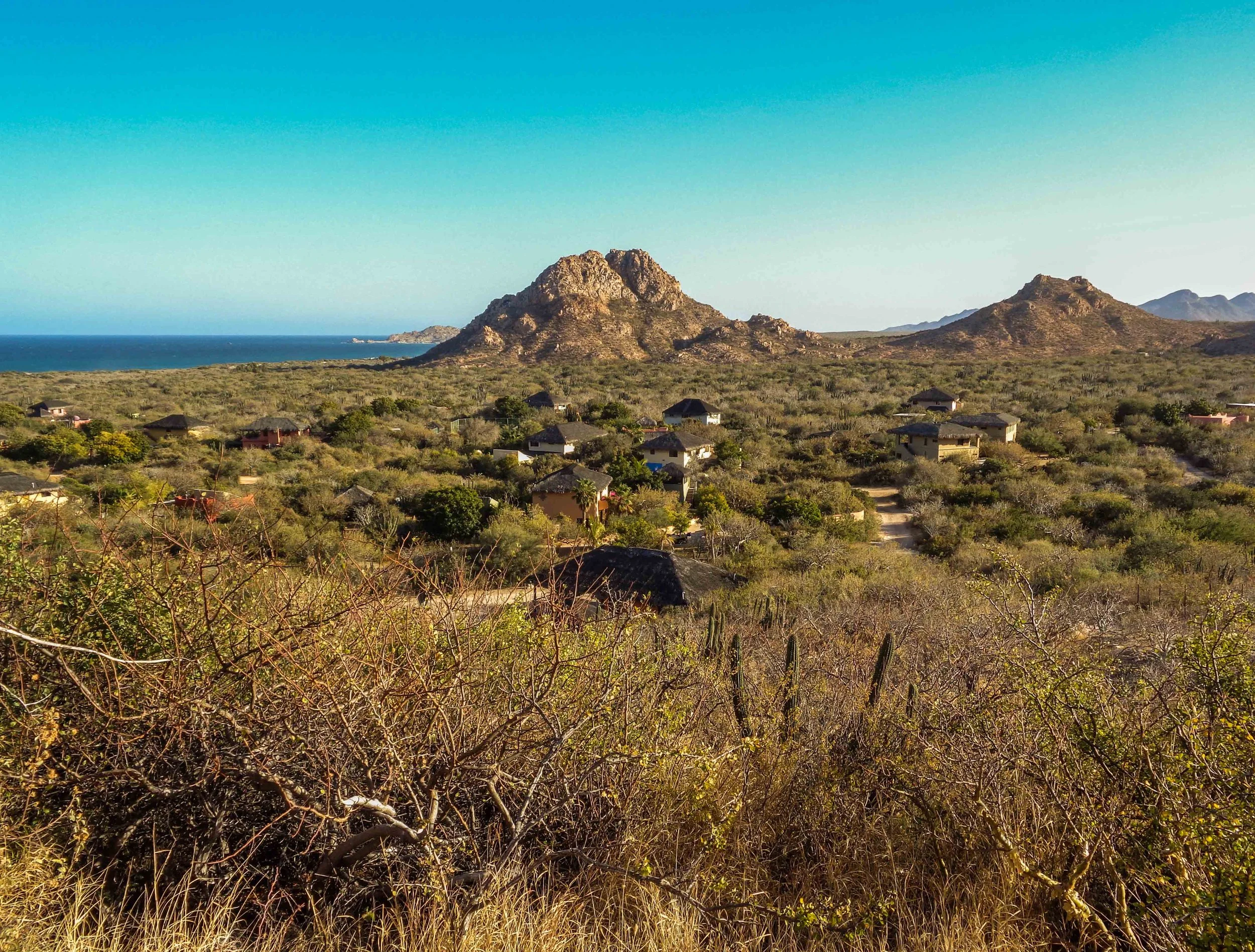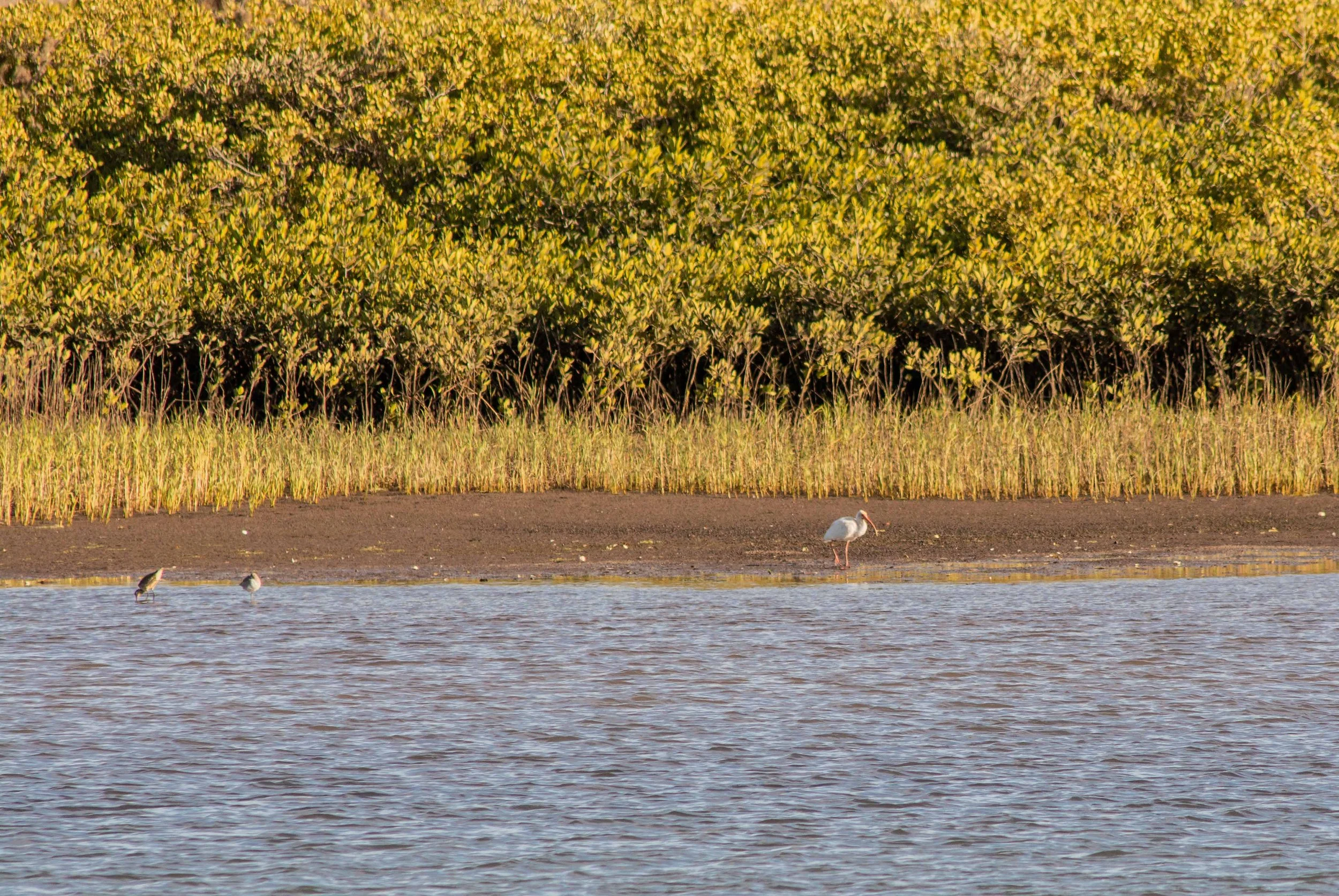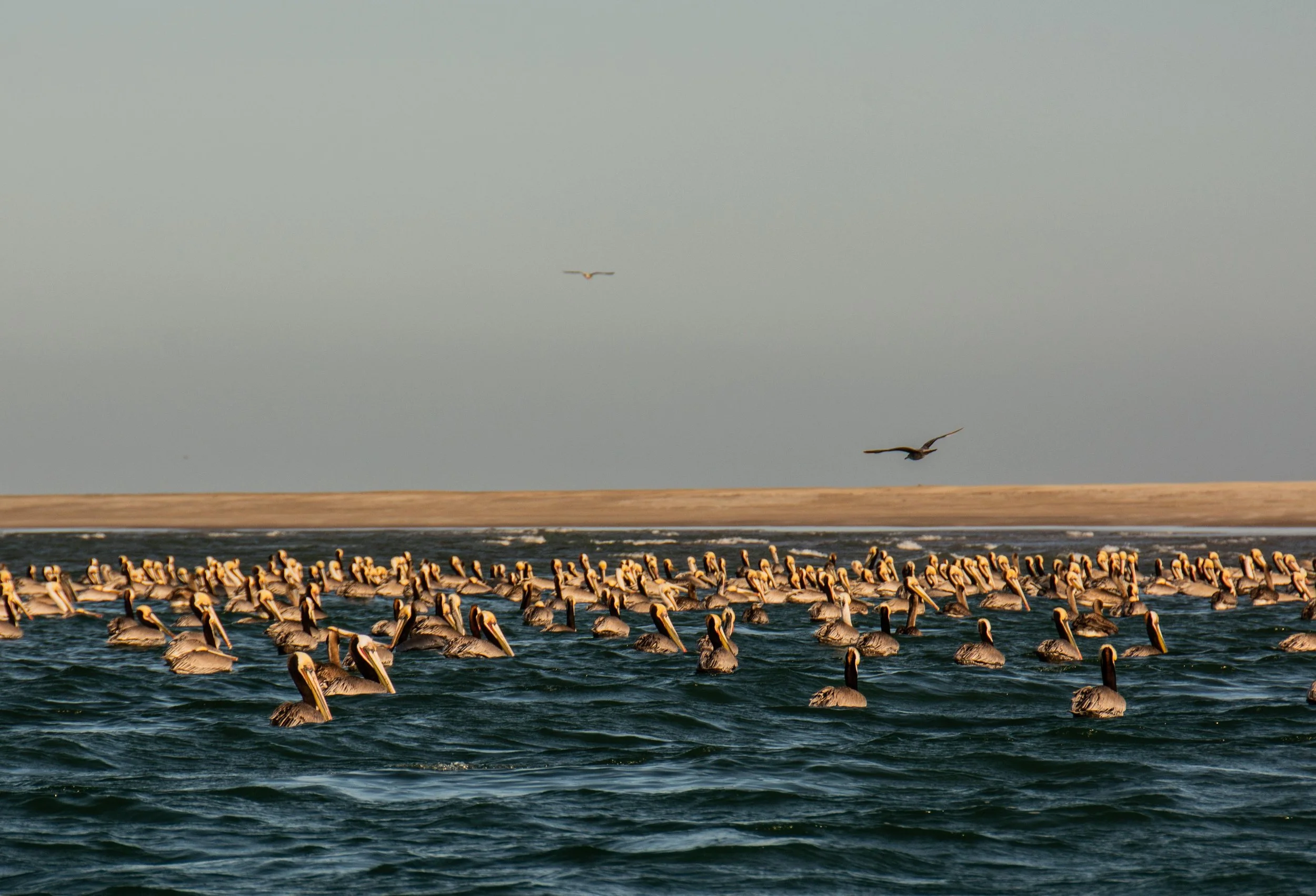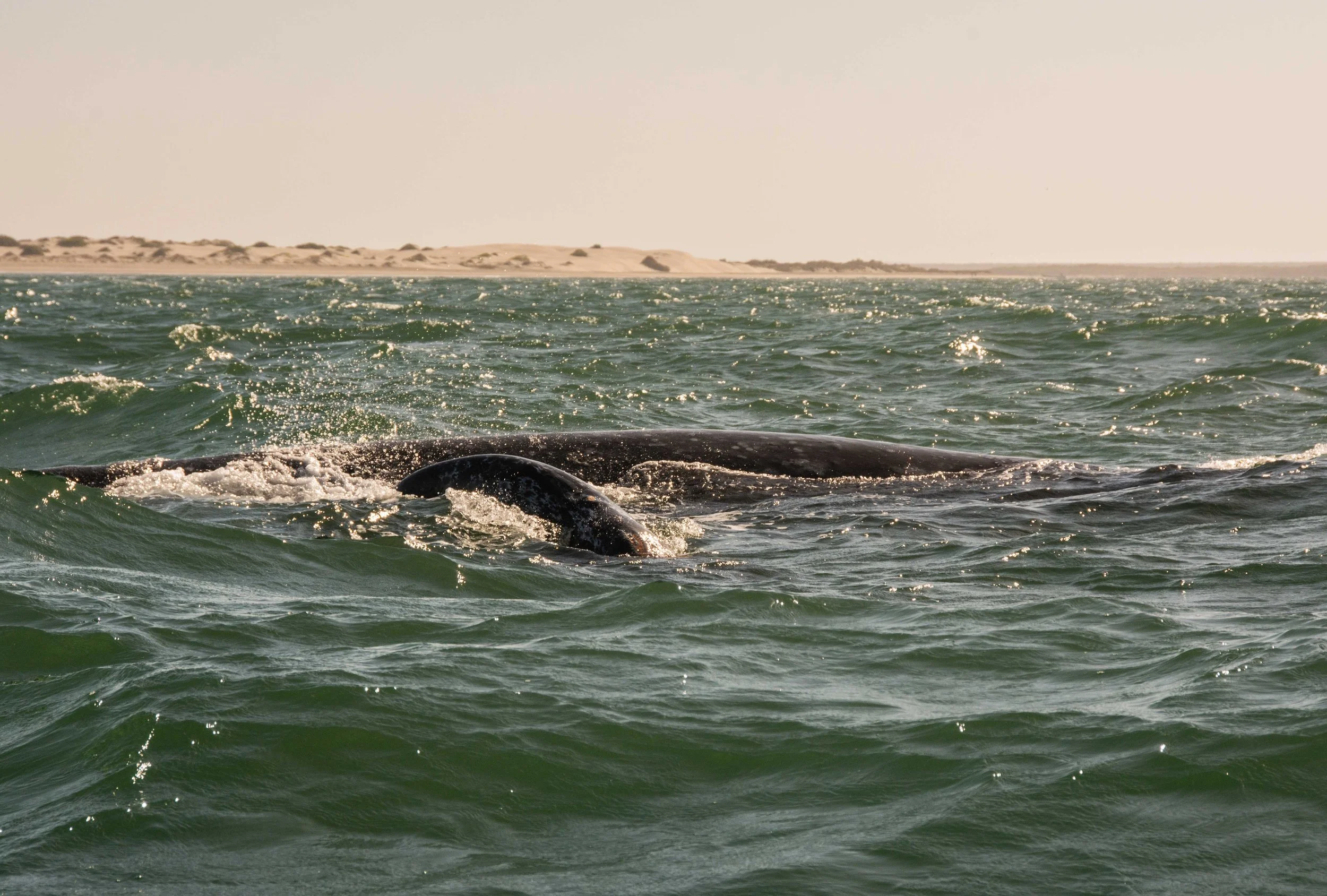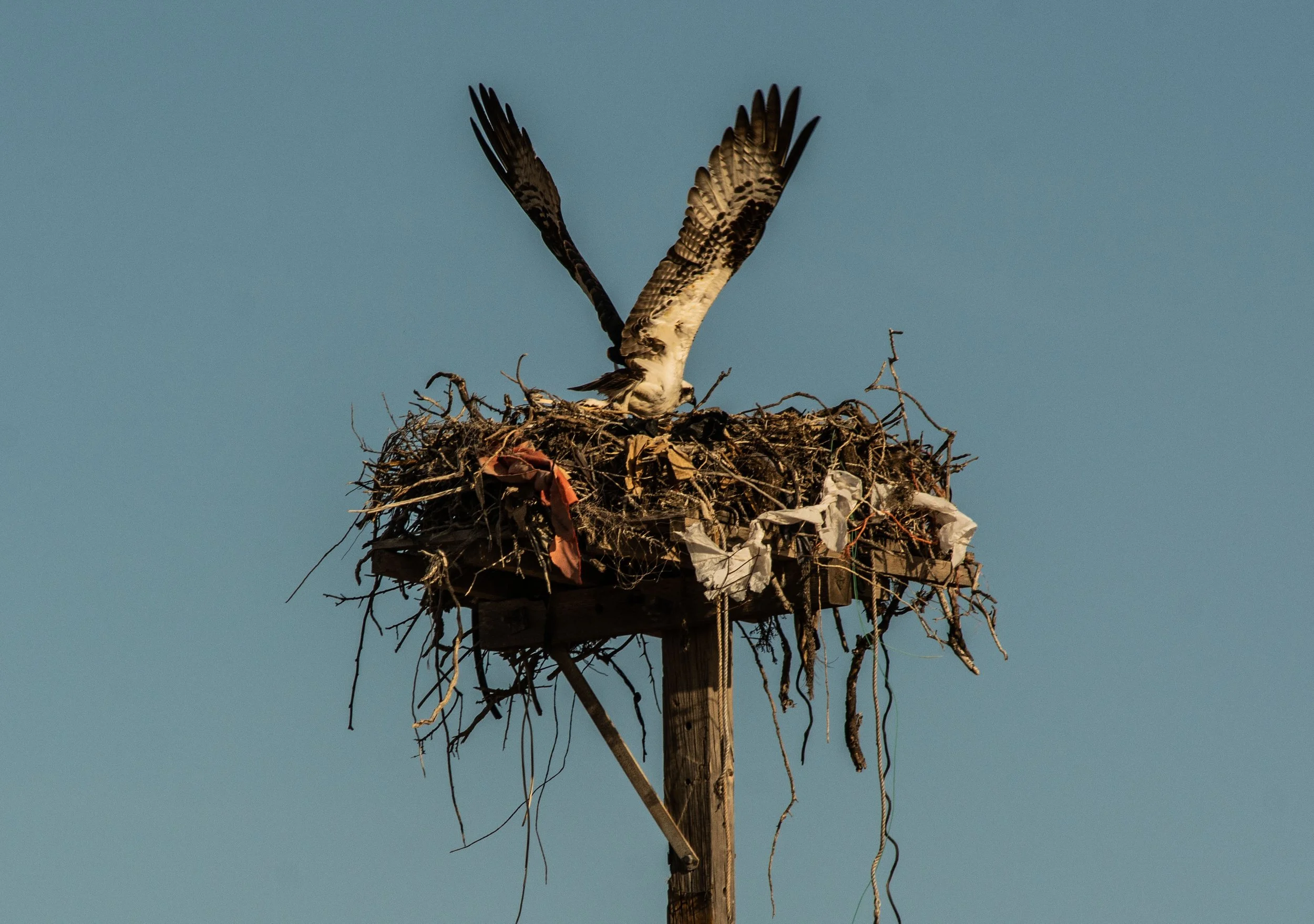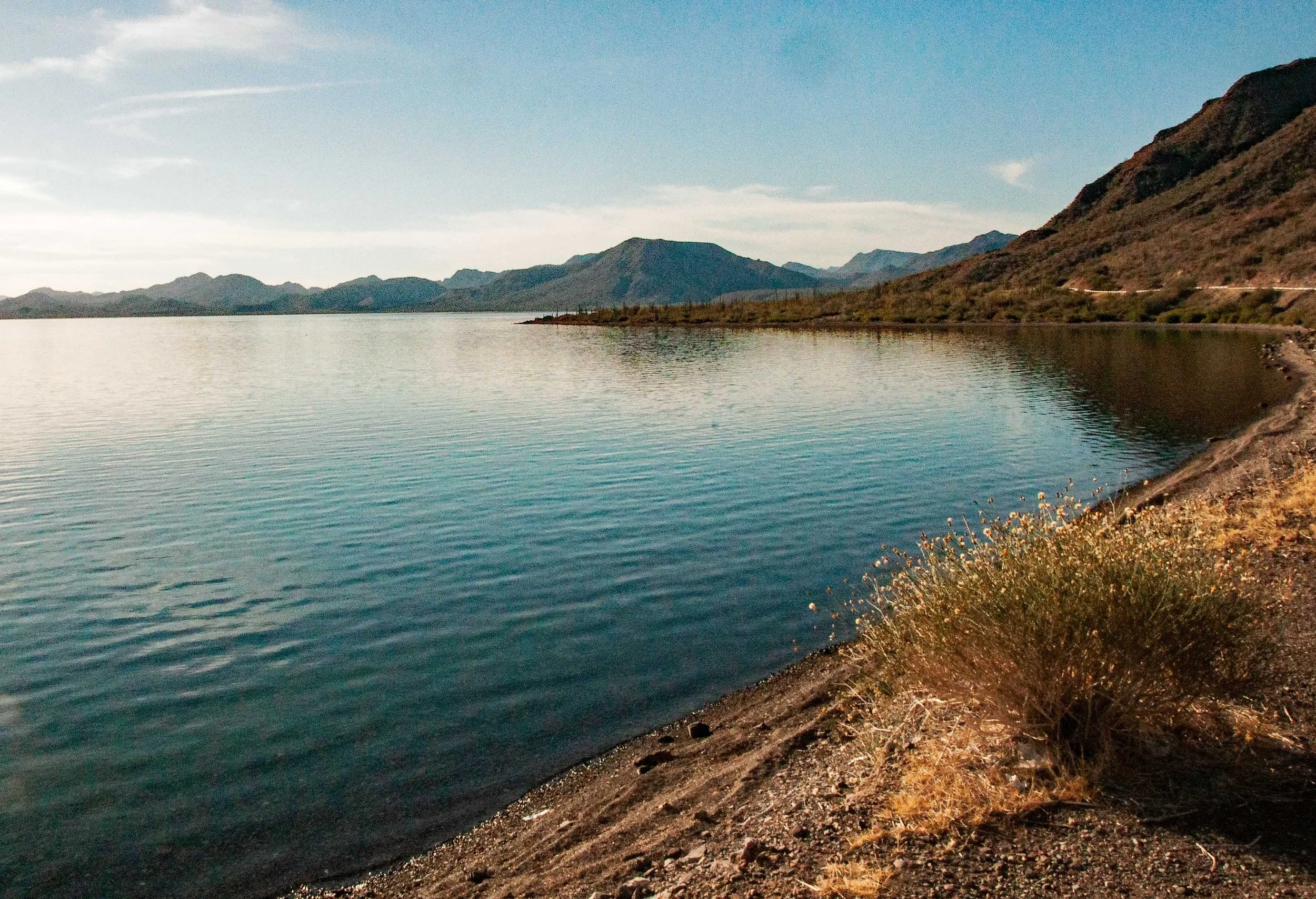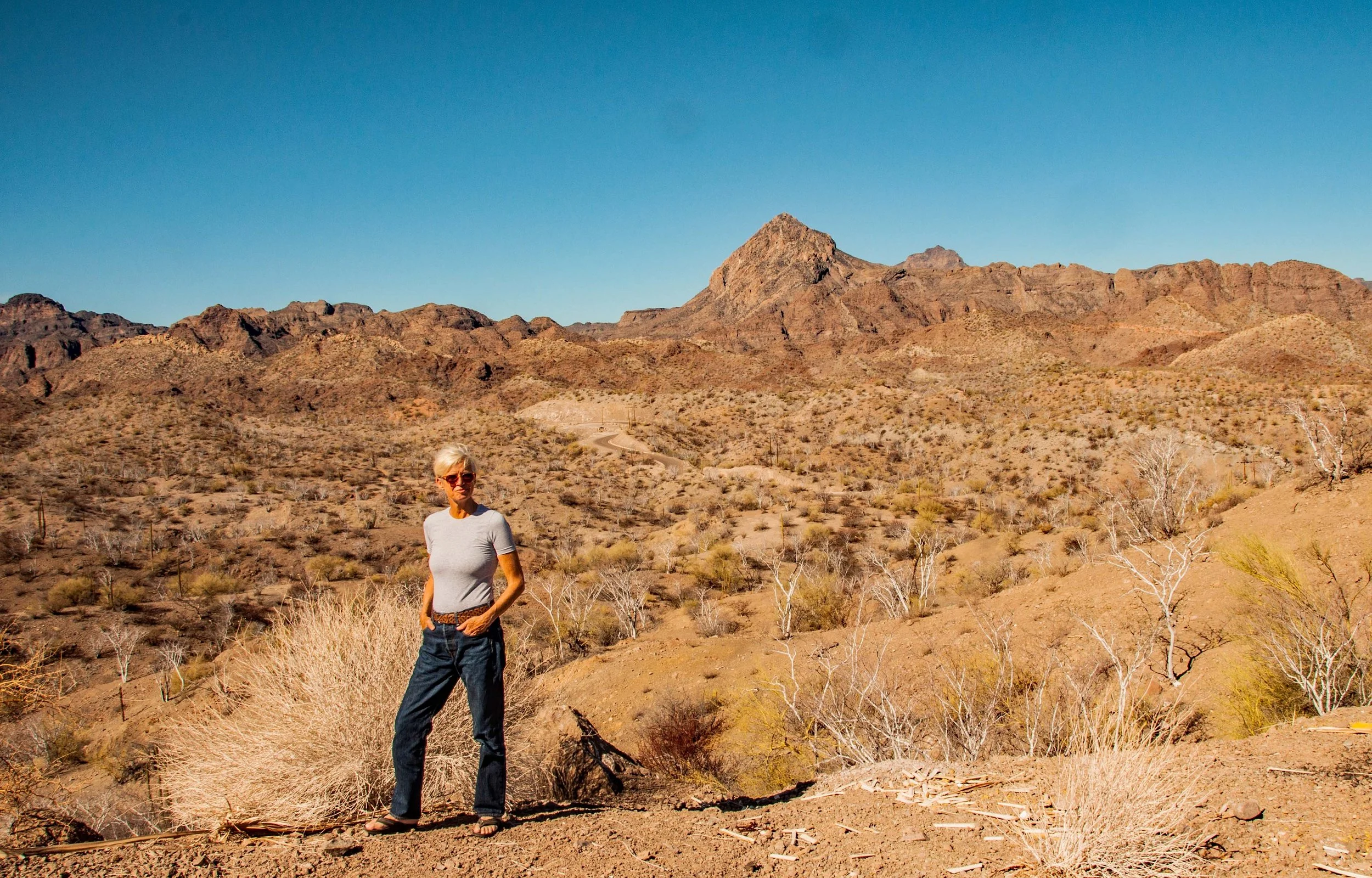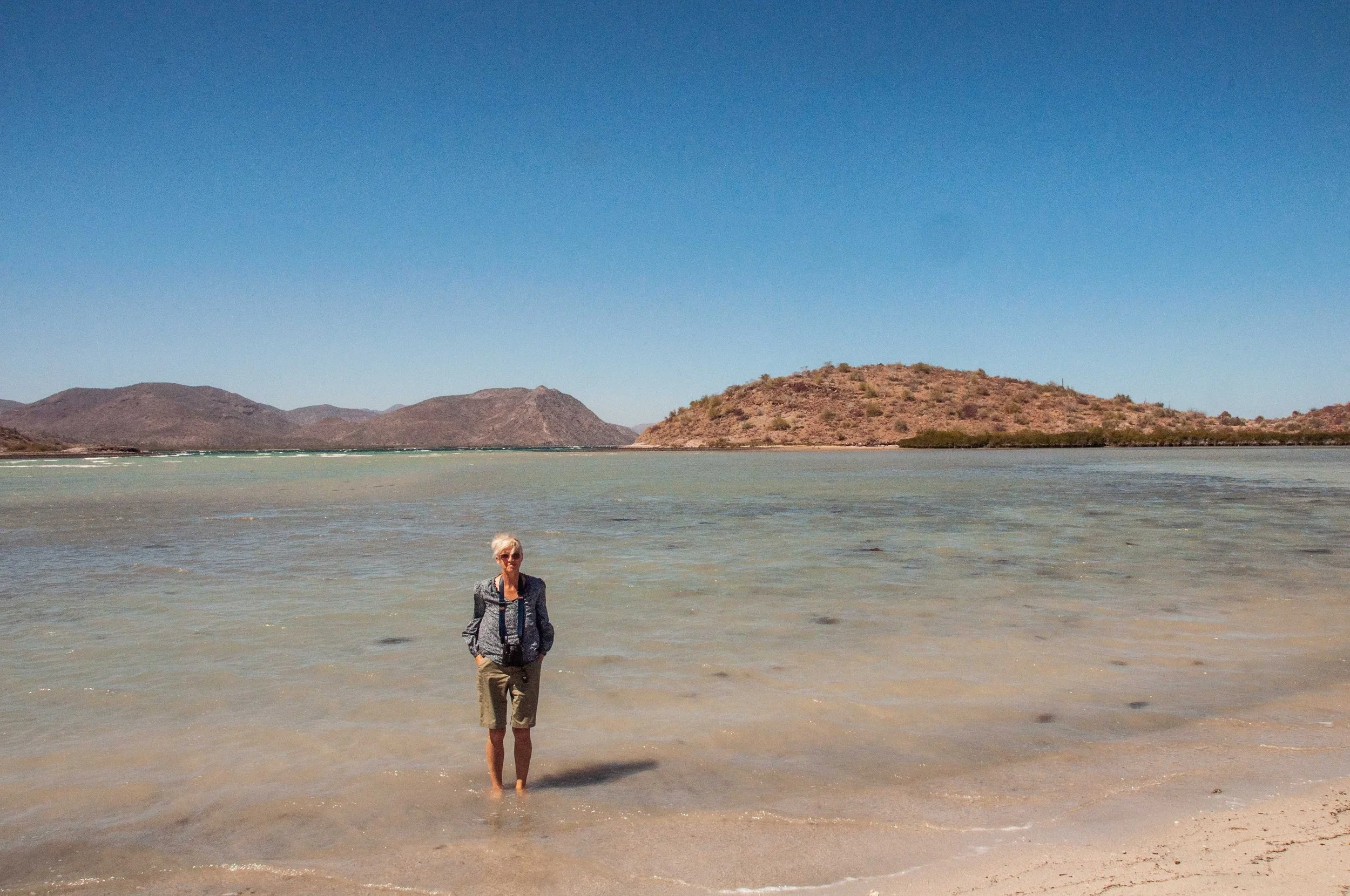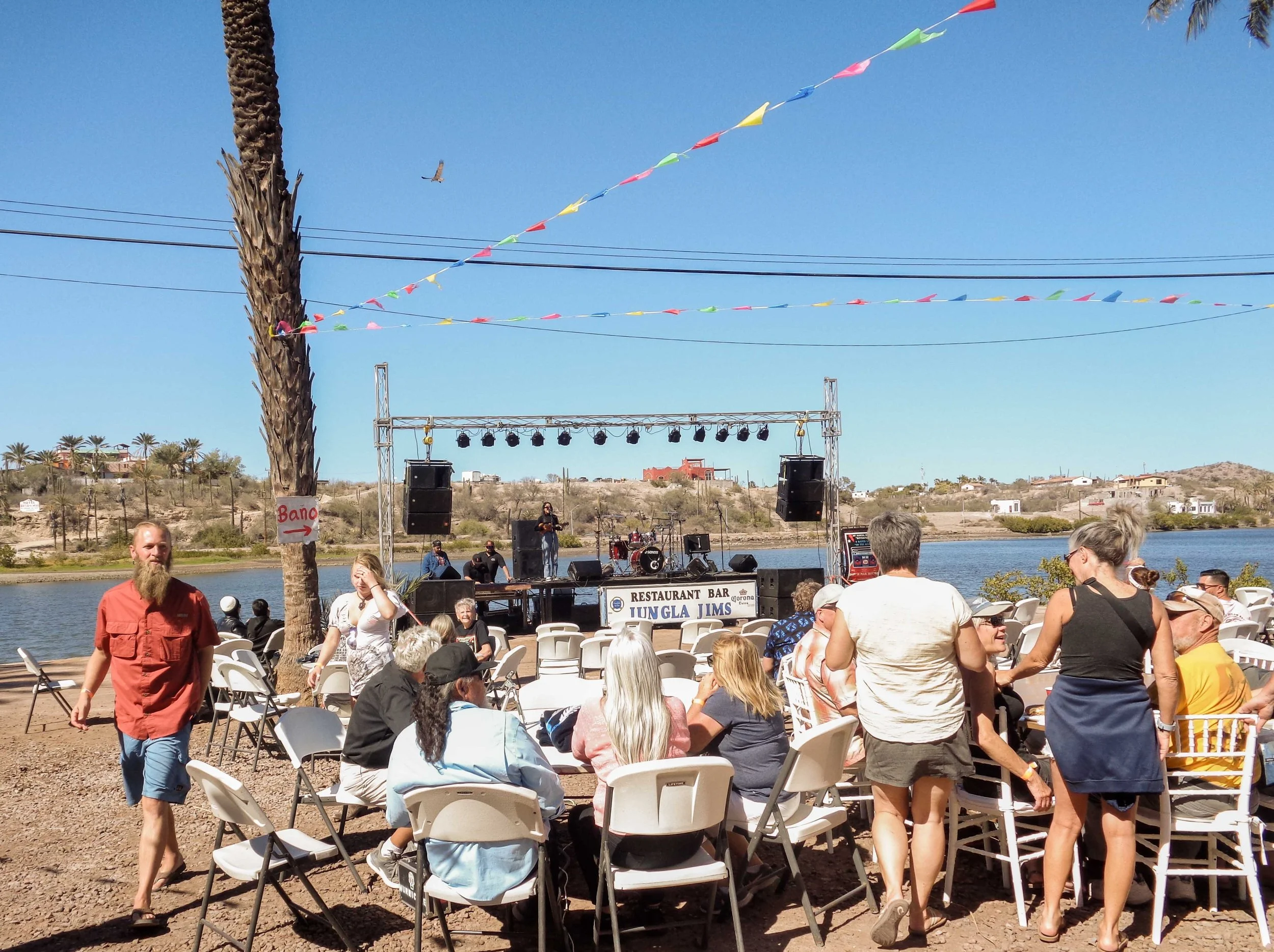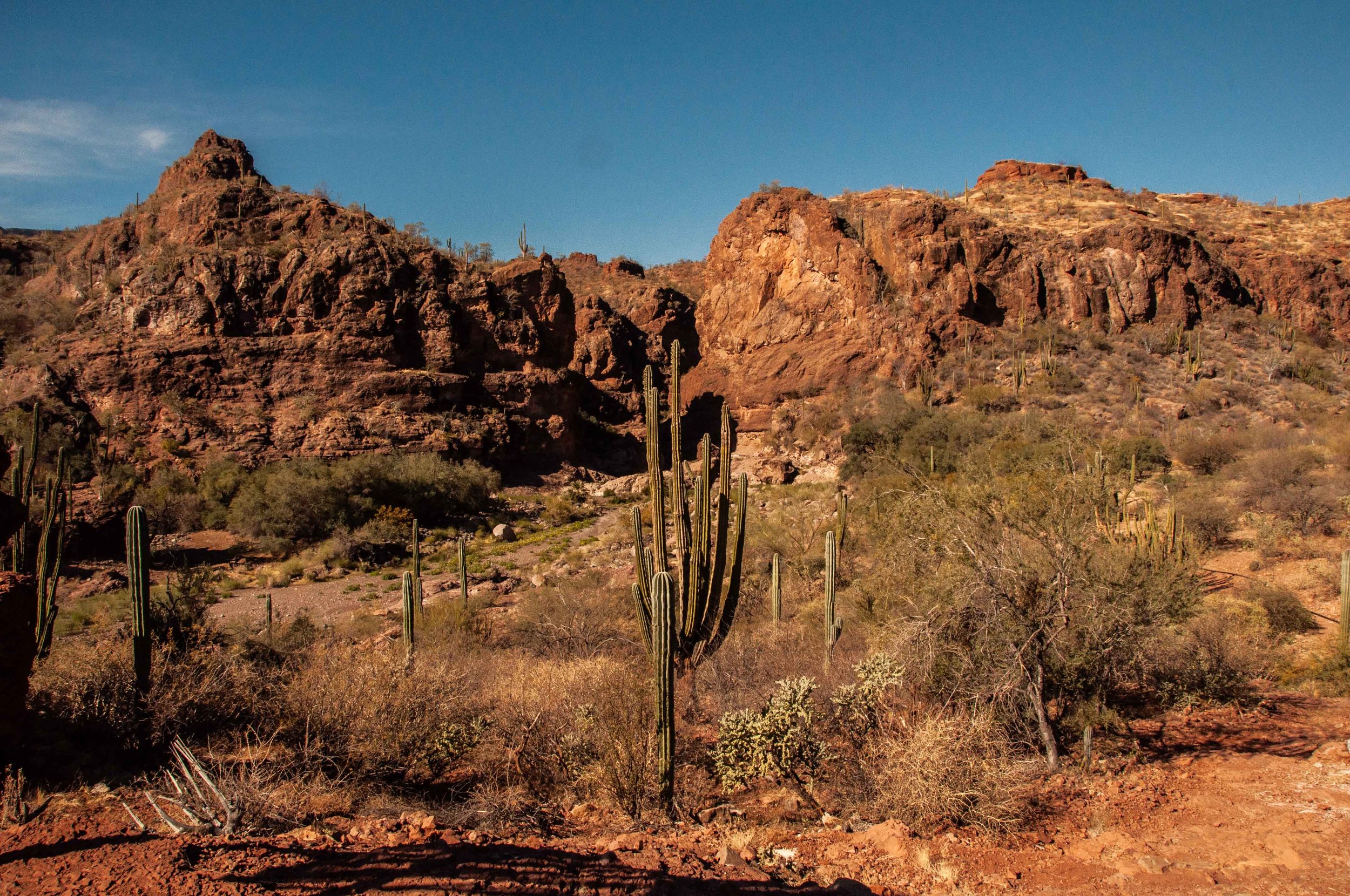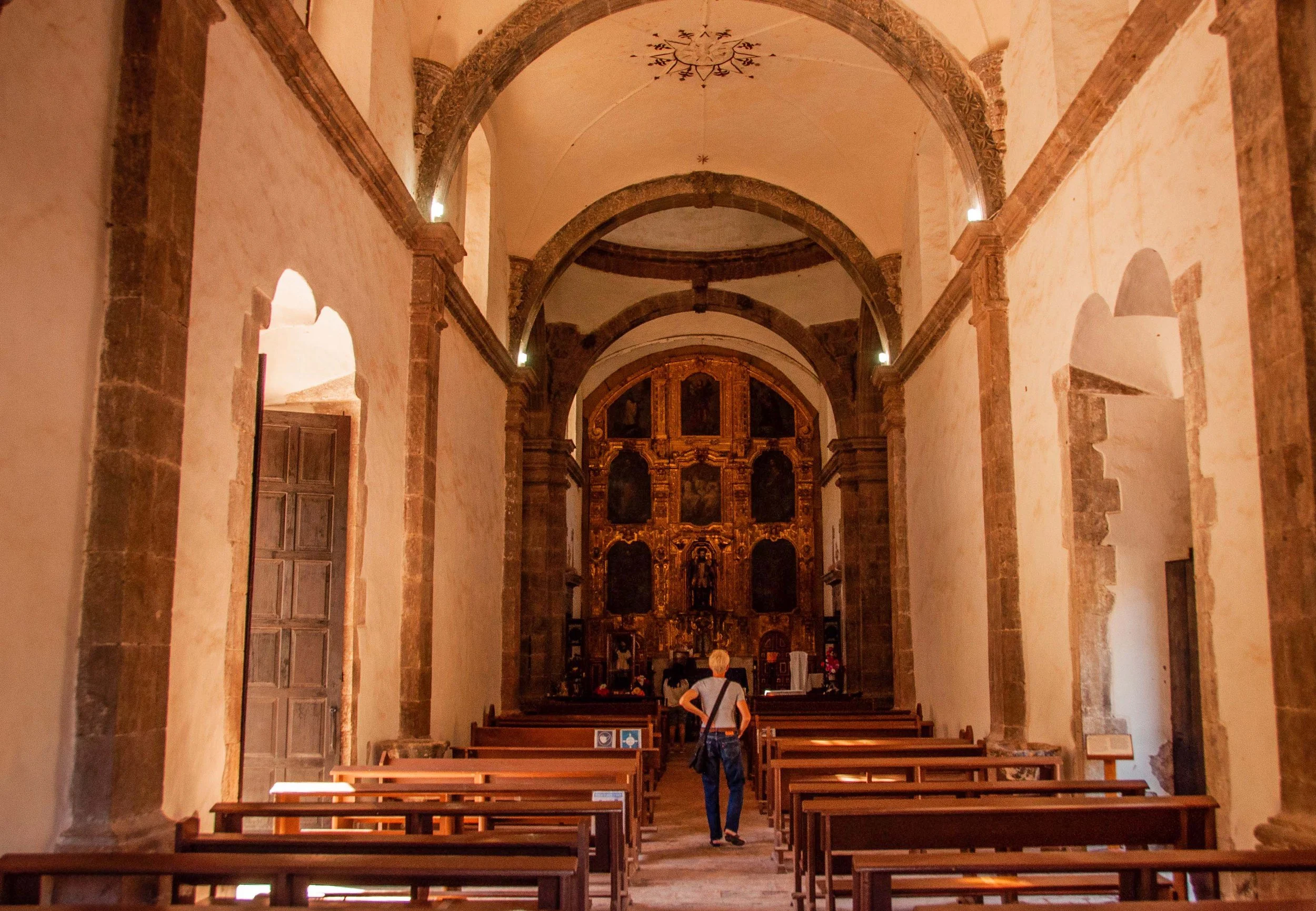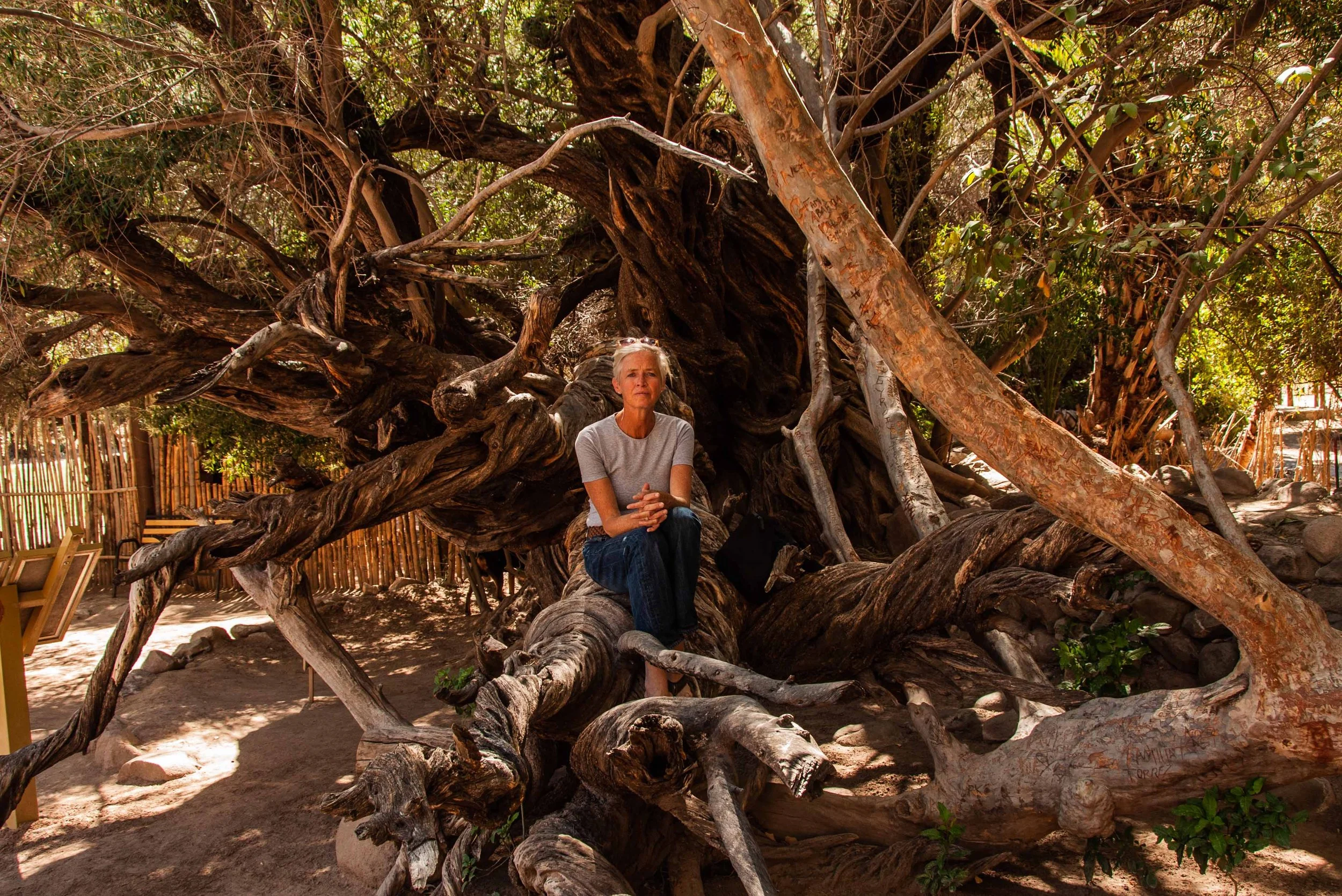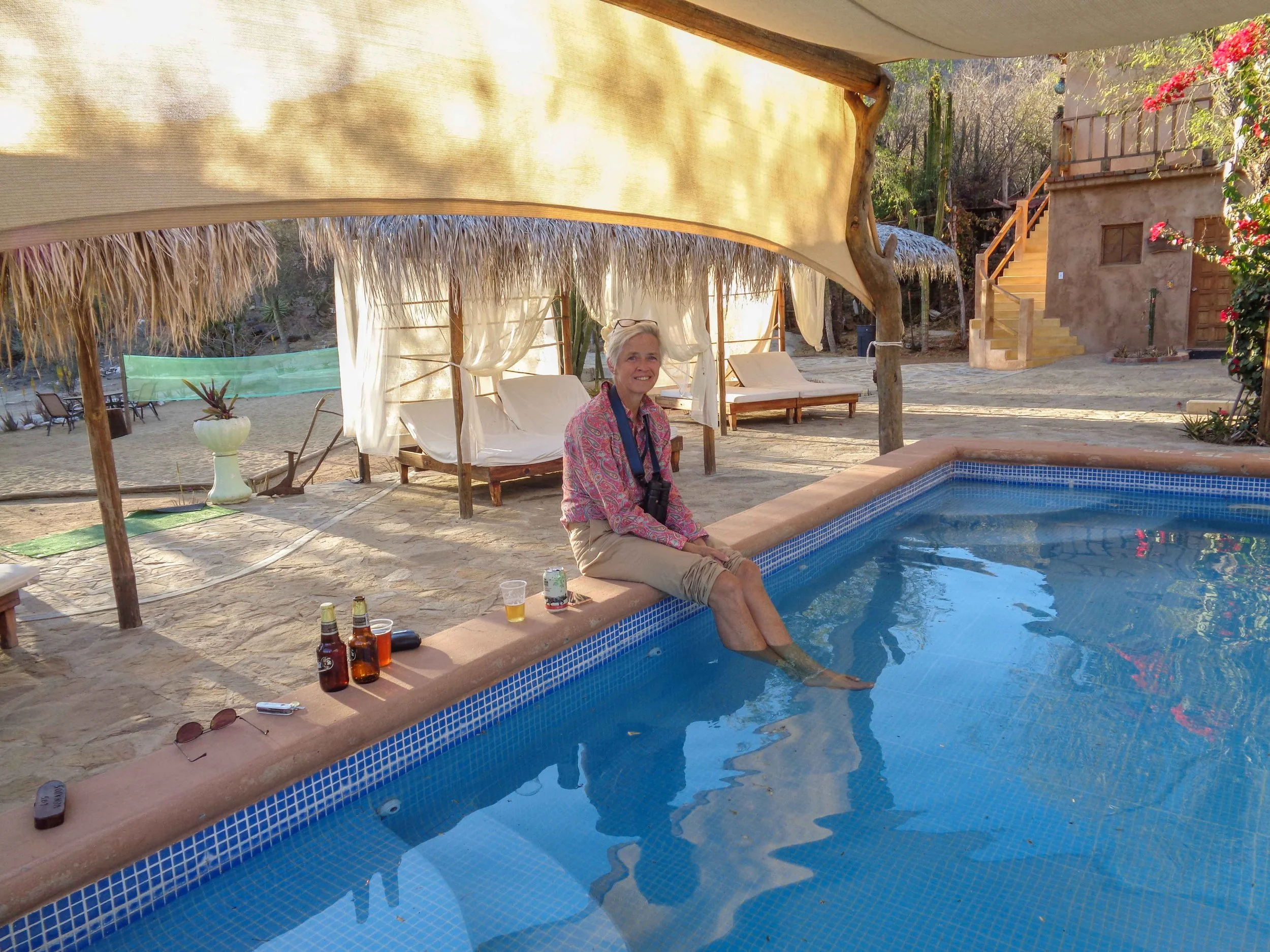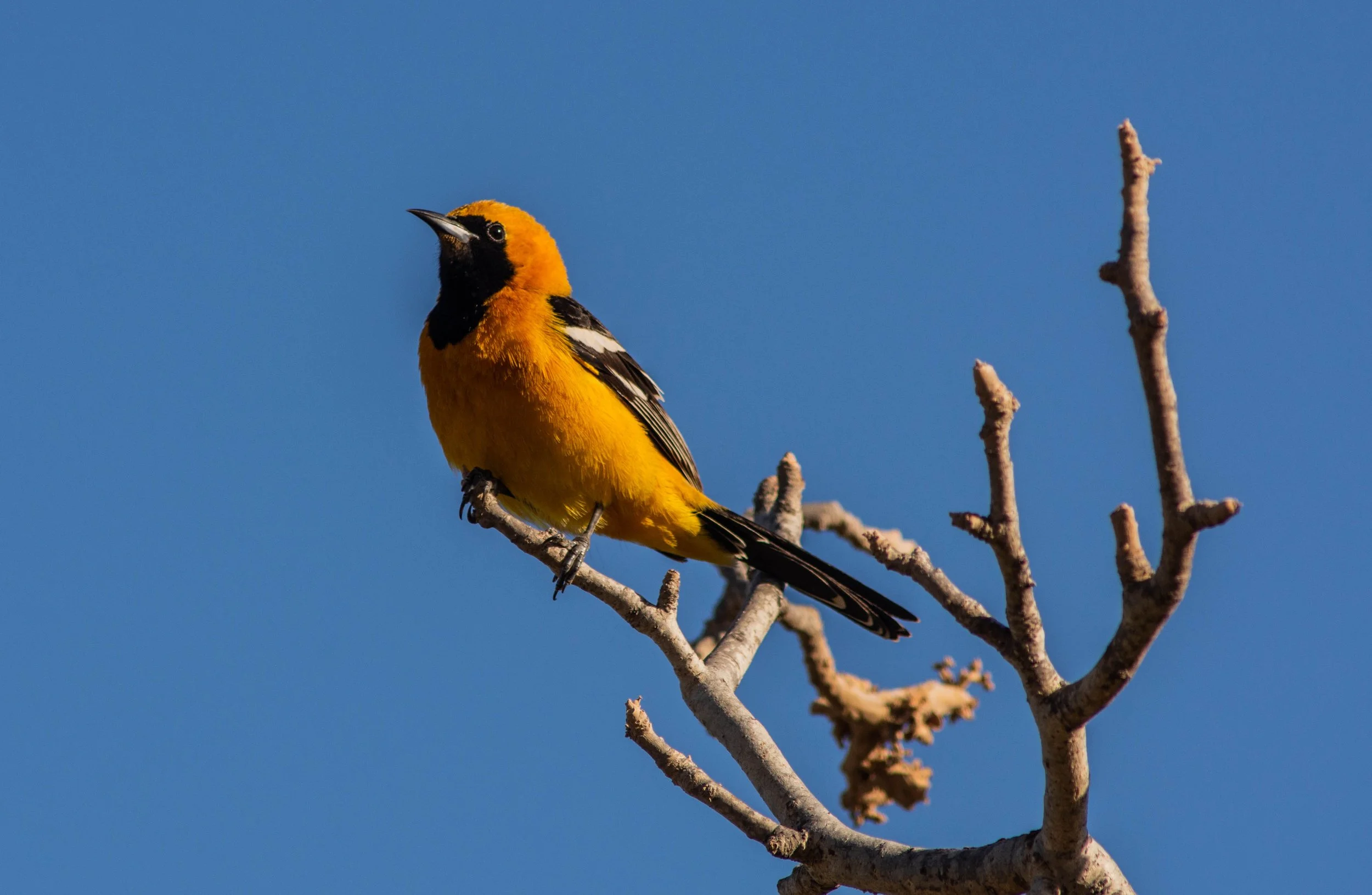Our trip to Baja California (which for brevity I will refer to as Baja for the rest of this blog) began by flying from Mexico City to San Jose del Cabo Airport (aka Los Cabos International Airport). The route took us over a spectacular range of mountains which I took to be the Sierra Madre Occidental and out over the Gulf of California, also known as the Sea of Cortez. We had booked a small car, a Chrysler Beat, in advance and after dealing with the paperwork, we were on our way.
1. The southern part of the peninsula showing most of the places we visited. Thank you google earth.
Cabo Pulmo
Our first stop was to be Cabo Pulmo, a small coastal town about 90 km north east of Los Cabos. After leaving the national road we bounced our way down a bad dirt road for 35 km that ends at the sea.
Cabo Pulmo is a part of a World Heritage Site and a national Marine Park and we hoped to go snorkelling and boating there. Unfortunately, it was extremely windy the whole time we were there, and no boats were going out and the water was far too rough and murky to be able to do any water sports at all.
2. The main street of Cabo Pulmo, ending directly at the water’s edge. Dive boats waiting for tourists and the wind to drop.
With the wind preventing us from snorkelling, or even swimming, we took the opportunity to just relax, walk on the beach and watch birds. There is a small restaurant at the water’s edge and we too had the time to enjoy our first meals of Baja seafood. Almost every house seems to offer some sort of service for tourists; bungalows, rooms to rent, coffee, food, dive boats, kayaks, you name it.
3. The view along the coast with the wall of the restaurant on the left
The coast line on the Gulf of California side of the peninsula, at least in the southern Baja, is very stony. The soils are soft, almost sandy, and easily eroded, and the stones are washed into the sea all along the coast. This makes walking uncomfortable in parts, but the stones are mostly confined to the water’s edge, with white sands behind them.
4. The stony beaches. It was just about here that we saw a thresher shark only a metre or so from the shore, apparently feeding on who knows what
From what we learned, the marine reserve has been a great success and the marine life has recovered well. And this means that birds dependent on the sea for their livelihoods, have also recovered. Gulls, shorebirds, osprey and pelicans were all there on the short strip of coast we saw.
5. Brown pelicans are common along the coast, diving for fish, almost like large, ungainly, gannets.
Although Cabo Pulmo has a permanent population of 61, in season it becomes a more crowded place once the tourist season gets under way.
When we walked a short distance inland, we found that Cabo Pulmo is obviously a holiday destination with a number of homes half-hidden in the bush. From the village, there was no indication of these homes; most were empty, but well maintained and looking to be the homes of the fairly affluent. And with the national reserve there, little chance of it becoming too built over.
6. Cabo Pulmo holiday homes bordering the national reserve. In fact, this was one of the greenest areas we saw in the whole of Baja
After 3 days (two nights) in what was a fairly basic but perfectly adequate bungalow, we left to drive across to the Pacific Coast for our first experience of whale watching. Whale-watching on the Pacific coast is with grey whales. On the gulf coast whale-watching is for blue and humpback whales.
Our destination was Puerto Chale, but on the way we stayed overnight in La Paz, the capital city of Baja California Sur. We would return to La Paz later in the trip to go swimming with the whale sharks in the bay of La Paz.
Puerto Chale
To call Puerto Chale a port is an exaggeration; a pop-up fishing village is more accurate. There are a couple of concrete structures, but most of the infrastructure is canvas / plastic sheeting stretched over wooden frames. But it serves its purpose, that of taking tourists out to see the grey whales which come into the bay to calve each year.
7. Puerto Chale. Note the tour bus. Puerto Chale is only a couple of hours by tour bus from La Paz
The calving season lasts from December to late March or early April after which the whales and their calves head north. The system appeared well organised, and although we did not find out the details, it seemed that the boats are organised into some sort of cooperative so that all get a fair share of the tourists.
8. At times it seemed as if the whales might surface under our little boat!
It is a 45-minute boat ride out to where the whales are to be found. There can, of course, be no guarantee of seeing whales, but the boat captains are very experienced, and we had no trouble finding two. In calm weather they have been known to come right up to a boat to have their noses scratched. However, once again the wind made the water too rough, but the experience of having a whale surface right next to the rather flimsy skiff was enthralling.
9. The tail of a whale that came very close to the boat, but (un)fortunately not close enough to be touched.
At the end of the trip, we had a delicious ceviche at one of the pop-up food stalls before heading on to our next destination and more whales. We didn’t stay overnight in Puerto Chale, in fact I don’t think there was any accommodation, and we were booked in at our next port-of-call, the magnificently named Puerto Adolfo Lopez Mateos, named after a former president of Mexico.
Adolfo Lopez Mateos
Our guest house, the Hotel Mangrove, was on the outskirts of the town. Not really a hotel, more of B &B, but architecturally interesting and very comfortable. Our room had a small deck with a lovely view over a tidal creek where we relaxed in the evening with a sundowner, or two.
10. The Mangrove Hotel / guest house overlooking a creek with mangrove swamps opposite
Low tide exposed mud flats on the opposite shore and good numbers of wading birds and herons arrived to feed on the exposed mud and shallows. This made for good birdwatching, but the distance was too far for any serious photography.
11. A distant white ibis and 2 godwits feed in at low tide in front of the mangroves.
Adolfo Lopez Mateos is quite a large town, the most important industry being commercial fishing, with a fish processing plant supporting the town. The port was more organised than at Puerto Chale, with booking offices and restaurants around the harbour square, and a jetty for the whale-watching skiffs.
12. Mateos small-boat harbour just after dawn before we set out
On our first evening we made our way down to the harbour to make a booking for going out to look for whales the following morning. While making our booking we met a young woman, Alejandra Manzanilla who writes a travel blog, and we agreed to share the cost of the boat. (Anybody wanting to read her blog can look it up. www.descubreteviajando.com. It is in Spanish but google will translate it.)
13. Chris and Alejandra waiting for their fish in the retstaurant in Mateo
The next morning, bright-eyed and bushy-tailed, we met at the harbour and were soon on our way. The fishing in the lagoons and out into the sea is very good and there were many seabirds, including a flock of several hundred pelicans we passed on our way.
14.Part of the flock of pelicans we passed. I estimated between 500 and 600 pelicans in the flock
Once we reached the deeper water where we expected to find whales, the wind and the swell increased considerably and the conditions became rough. At the mouth of the bay there was a line of breakers and as the wind increased so did the swells. But we did find whales and in spite of the rough water we approached quite close to them.
15. A whale surfacing and “blowing” alongside our skiff. Close enough to put spray over our camera lenses, and us.
16. A whale with her calf. The calf surfaced suddenly and looked at us. By the time I had reacted it had its head under the water again. Sorry about that.
Ospreys, fishing eagles, seem to be specially appreciated / conserved around Mateo. Nesting platforms have been erected all around the town and out along the road leading into the town. We counted 26 of these platforms, all occupied by nesting ospreys, as we left. And there were many more we didn’t count.
17. An osprey on its nest of sticks, plastic bags, bits of fabric, string and rope.
Our most northerly destination was the town of Mulegé on the estuary of the Mulegé River where it flows into the Gulf of California. This meant crossing the peninsula again and driving north along the gulf coast. This turned out to be a beautiful drive, first crossing the Sierra de la Giganta and then meandering up the coast from Loreta. The coast is spectacular, the mountains close to the coast and in places right to the sea with the views rivalling, even surpassing, Chapman’s Peak drive in Cape Town, for those of you who know the Cape.
18. The Sierra de la Giganta sweep down to the Gulf of California / Sea of Cortez
But that was the coast. The interior was dry; even by the standards of the rest of the Baja, it was dry. And where it is dry there is cacti in abundance. We both loved this countryside; there is little vegetation between the cacti, but it has spare beauty that we both appreciated.
19. The drylands East of the Sierra de la Giganta
The coastal road revealed many beautiful bays of white sands and crystal-clear water, even though the wind continued to blow hard. Some of these bays have been developed into holiday resorts and large caravan parks, but many remain relatively undeveloped.
20. A stop along the way. Still undeveloped except for a small caravan park.
Mulegé
We arrived in Mulegé just in time, unfortunately, for the start of the “First Annual Mulegé Music Festival”. We had the horrible thought that it might be going on for the whole weekend, but fortunately, it only lasted for one day, and finished around midnight. It was almost entirely American; both the audience and the musicians.
21. The massed crowds at the First Annual Mulegé Music Festival
The official name of the town is “Heroica Mulegé” a title given to it for its role in defeating the invading Americans during the Mexican – American war in the 19th century. The Americans, having failed to conquer it, have taken it by tourism instead. The south side of the river, where we were staying, is almost entirely American holiday homes and guest houses. The north bank of the river is almost exclusively Mexican.
One of the attractions of Mulegé for us is that the area has been inhabited for thousands of years and there are cave paintings inland from the town. We had the name and phone number of a guide who took tours to the paintings and we arranged a trip with him. At 6.30 am he picked us up and drove the 30km inland to the La Trinidad ranch the paintings are found.
22. The foothills of the Sierra de Guadalupe on la Trinidad.
It seldom rains in Mulegé and when it does it often comes in the form of hurricanes, so although the country is dry, it is heavily eroded, with deep valleys with sandy floors. From the farmhouse we walked a further 6km to the paintings in the Sierra de Guadalupe.
23. The paintings show whales, fish, various animals and people. We were particularly taken with row of hands, top right.
Mulegé is a beautiful town and we would love to have explored it further, but time was short and after 2 nights we left to drive south to La Paz and swimming with whale sharks.
On our way to La Paz we made a detour into the mountains to visit a restored mission station the San Francisco mission. To give its full name, the San Francisco Javier de Viggé-Biaundó mission and was founded by the Jesuits in in the late 17th century to convert the Cochimí people. It was abandoned in 1817, but has recently been restored by a government agency.
24. The San Francisco Javier de Viggé-Biaundó mission church.
It was a long and winding road – as the saying goes – of 43 km through the mountains. But once there it was obvious why the mission had been established there. Water. This enabled them to establish gardens and among the early crops planted were olive trees.
25. Sitting on the twisted limbs of a 300 year-old olive tree.
We still had a way to go, so we didn’t stay long, but long enough to buy a jar of olives and a bottle of fresh orange juice pressed from the local orchards. There is still a small population living there, sustained by their agriculture and the tourists who visit the church. And so, back along the long-and-winding-road and on to La Paz.
La Paz
The tourist season begins with the so-called “spring break” in the US, when numbers of Americans take to their RVs and drive down the Baja peninsula and take their holidays on the coast. We were fortunately just ahead of the main wave, but there were certainly many US tourists wherever we went. We were told that 35% of the population of La Paz are American. We were travelling just ahead of the vacation invasion, and most of the US travellers we met were also travelling to avoid their compatriots.
La Paz is the capital city of Baja California Sur (South) and lies at the southern end of the Bay of La Paz. There is a very bay within the bay which gives very good protection from storms and is a popular yacht and small boat mooring and it is from this bay that the whale shark activities are organised.
26. La Paz harbour from the roof -top balcony of our hotel
A word on the swimming with whale shark tours. They are very well organised and conservation organisations everywhere could learn from them. For a start, only a limited number of boats are licensed and before going out they have to check in with the conservation authority, which allows only a limited number of boats out at any one time. If the quota of boats is already out, any further boats just have to wait for one to return, opening a slot for them. No boat is allowed out for more than 90 minutes, and once a whale shark is sighted, no more than one dive boat is allowed to follow it. There is also a strict speed limit of 5 knots.
All of this is controlled and monitored by a microchip and gps attached to every boat’s outboard motors. And all boats are visible, and watched from the land. ANY breach of these rules can lead to the suspension of the licence to operate. And of course, there is a limit, I think 10, to the number of swimmers / divers to each boat.
27. Whale shark. Filter feeders, they swim along with their mouths open filtering out the copepods in the water.
We do not have underwater cameras so we were reliant on the photos taken by our dive guide. We took it in relays to dive with the whale shark. Our boat would travel ahead of the shark and then 2 or 3 of us would enter the water and wait for the whale shark to arrive. “Our” shark was not that big, probably around 6 metres, but they grow much bigger. They move much faster than expected from the lazy waving of their tales, and even with maximum exertion it is not possible to keep up with them for more than a few metres.
28 . The southerly winds concentrate the copepods at the south end of the bay at this time of year, bringing in the whale sharks to feed and give birth.
If anybody is interested, they can look at the videos taken by our dive captain, he was always in the water with us, in Dropbox "15 Marzo TB Baloo 9 pax".
It was a fantastic experience, and well organised, with the well-being of the whale shark uppermost at all times. To give an idea of the organisation, one boat signalled to us that they had been unable to find a whale shark, and their allotted 90 minutes was nearly up. If a boat does not find a shark in its allotted time its customers miss out, and that’s it. Would we be prepared to pull back and give up some of our time so that their customers could get at least one dive with a whale shark. Of course, we agreed and stood back to allow them to make their dives.
El Triunfo
From La Paz we drove south toward an ex-mining town El Triunfo, and a likely looking lodge, with swimming pool, that Ursula had found on the internet. Leaving La Paz we were delayed by a police stop, the policeman insisting that we had jumped a red light and been speeding. He wanted US$200. We had not broken either law, and Ursula was having none of it and persuaded / bullied him into retreating back to his vehicle, grumbling about foreigners. We think it was because we were on the road to the airport and he assumed we would just back down rather than miss our flight. Once he discovered we were not flying, the situation changed.
After that little interruption we continued, legally, on our way. We arrived at the lodge at around 5.30pm. They had no restaurant and, we discovered, all 3 restaurants in the town closed at 5 pm. But they did have a welcome swimming pool. Eventually, at a corner store, still open, and we found beer and some cold buritos. I enjoyed them. Ursula less impressed.
29. A welcome beer at the poolside.
El Triunfo is an old gold and silver mining town, but the mines long-since closed the population has dwindled from about 10,000 at its height, to now numbering about 500. We learned all this from a really wonderful museum with delightfully arranged exhibits, and imaginative interactive displays detailing the history of the town. It was an excellent museum and stands comparison with any we have seen elsewhere. And it had a really good restaurant attached.
30. A mural on the town square depicting the mining history of the town
We managed a longish walk in the dusty heat of the hills above the mine, the pool was most welcome at the end of it. We discovered a really excellent fish restaurant (that closed at 5pm – we never did discover why this early closing hour – perhaps something to do with covid) and a cactus conservation area a few km down the road. Who would have thought it would be necessary to have such an institution in the home of the cactus.
31. Cattle amongst the cactus. We never really understood what they found to eat, but they looked quite healthy.
We had intended to stay one night in El Triunfo, but we enjoyed the little town, the seafood restaurant and, last but not least, the swimming pool so much that we stayed for 3 nights. After 10 days on the road it was great to relax, chill-out and explore the countryside, and do a bit of bird watching.
32. The Hooded Oriole was a very common bird wherever we travelled in Baja
Eventually we had to leave the joys of El Triunfo and on the final day of our travels in Baja California Sur we headed south to the airport and the car hire depot. The flight back was uneventful, but it was a bit of a shock to be back in the Mexico City traffic after the empty roads of Baja California Sur. But it was good to be back with Jutta, Arturo and the girls again for the last week in Mexico.
One thing I haven’t mentioned is the food. Fish, fish and more delicious fish, almost always raw. Ceviche of course, but also lots of simply raw fish, and it was delicious. Cooking such wonderful fresh fish almost seemed to be sacrilegious. In fact, the one meal we had with grilled fish was not a good one, the fish was overdone and dry.
It had been a wonderful trip and we seriously recommend it to everyone. And so much more to see next time.
Love to all
Chris and Ursula


